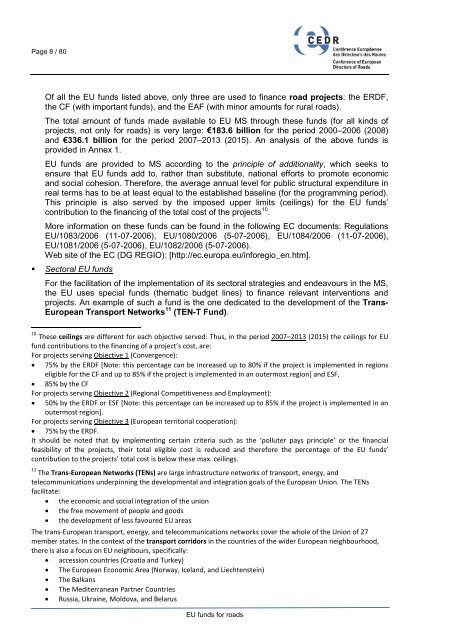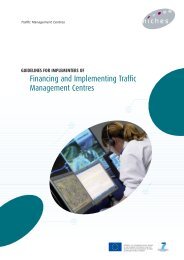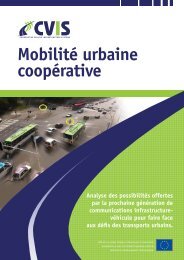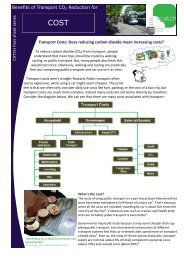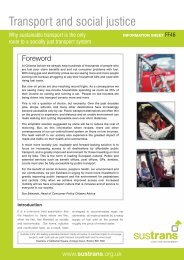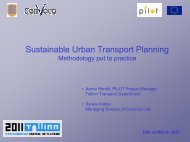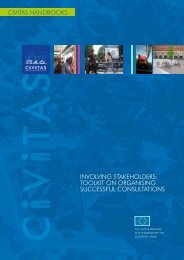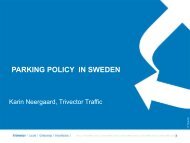EU funds for roads - CEDR
EU funds for roads - CEDR
EU funds for roads - CEDR
You also want an ePaper? Increase the reach of your titles
YUMPU automatically turns print PDFs into web optimized ePapers that Google loves.
Page 8 / 80<br />
Of all the <strong>EU</strong> <strong>funds</strong> listed above, only three are used to finance road projects: the ERDF,<br />
the CF (with important <strong>funds</strong>), and the EAF (with minor amounts <strong>for</strong> rural <strong>roads</strong>).<br />
The total amount of <strong>funds</strong> made available to <strong>EU</strong> MS through these <strong>funds</strong> (<strong>for</strong> all kinds of<br />
projects, not only <strong>for</strong> <strong>roads</strong>) is very large: €183.6 billion <strong>for</strong> the period 2000–2006 (2008)<br />
and €336.1 billion <strong>for</strong> the period 2007–2013 (2015). An analysis of the above <strong>funds</strong> is<br />
provided in Annex 1.<br />
<strong>EU</strong> <strong>funds</strong> are provided to MS according to the principle of additionality, which seeks to<br />
ensure that <strong>EU</strong> <strong>funds</strong> add to, rather than substitute, national ef<strong>for</strong>ts to promote economic<br />
and social cohesion. There<strong>for</strong>e, the average annual level <strong>for</strong> public structural expenditure in<br />
real terms has to be at least equal to the established baseline (<strong>for</strong> the programming period).<br />
This principle is also served by the imposed upper limits (ceilings) <strong>for</strong> the <strong>EU</strong> <strong>funds</strong>’<br />
contribution to the financing of the total cost of the projects 10 .<br />
More in<strong>for</strong>mation on these <strong>funds</strong> can be found in the following EC documents: Regulations<br />
<strong>EU</strong>/1083/2006 (11-07-2006), <strong>EU</strong>/1080/2006 (5-07-2006), <strong>EU</strong>/1084/2006 (11-07-2006),<br />
<strong>EU</strong>/1081/2006 (5-07-2006), <strong>EU</strong>/1082/2006 (5-07-2006).<br />
Web site of the EC (DG REGIO): [http://ec.europa.eu/in<strong>for</strong>egio_en.htm].<br />
• Sectoral <strong>EU</strong> <strong>funds</strong><br />
For the facilitation of the implementation of its sectoral strategies and endeavours in the MS,<br />
the <strong>EU</strong> uses special <strong>funds</strong> (thematic budget lines) to finance relevant interventions and<br />
projects. An example of such a fund is the one dedicated to the development of the Trans-<br />
11<br />
European Transport Networks (TEN-T Fund).<br />
10 These ceilings are different <strong>for</strong> each objective served: Thus, in the period 2007–2013 (2015) the ceilings <strong>for</strong> <strong>EU</strong><br />
fund contributions to the financing of a project’s cost, are:<br />
For projects serving Objective 1 (Convergence):<br />
• 75% by the ERDF [Note: this percentage can be increased up to 80% if the project is implemented in regions<br />
eligible <strong>for</strong> the CF and up to 85% if the project is implemented in an outermost region] and ESF,<br />
• 85% by the CF<br />
For projects serving Objective 2 (Regional Competitiveness and Employment):<br />
• 50% by the ERDF or ESF [Note: this percentage can be increased up to 85% if the project is implemented in an<br />
outermost region].<br />
For projects serving Objective 3 (European territorial cooperation):<br />
• 75% by the ERDF.<br />
It should be noted that by implementing certain criteria such as the ‘polluter pays principle’ or the financial<br />
feasibility of the projects, their total eligible cost is reduced and there<strong>for</strong>e the percentage of the <strong>EU</strong> <strong>funds</strong>’<br />
contribution to the projects’ total cost is below these max. ceilings.<br />
11 The Trans-European Networks (TENs) are large infrastructure networks of transport, energy, and<br />
telecommunications underpinning the developmental and integration goals of the European Union. The TENs<br />
facilitate:<br />
• the economic and social integration of the union<br />
• the free movement of people and goods<br />
• the development of less favoured <strong>EU</strong> areas<br />
The trans-European transport, energy, and telecommunications networks cover the whole of the Union of 27<br />
member states. In the context of the transport corridors in the countries of the wider European neighbourhood,<br />
there is also a focus on <strong>EU</strong> neighbours, specifically:<br />
• accession countries (Croatia and Turkey)<br />
• The European Economic Area (Norway, Iceland, and Liechtenstein)<br />
• The Balkans<br />
• The Mediterranean Partner Countries<br />
• Russia, Ukraine, Moldova, and Belarus<br />
<strong>EU</strong> <strong>funds</strong> <strong>for</strong> <strong>roads</strong>


